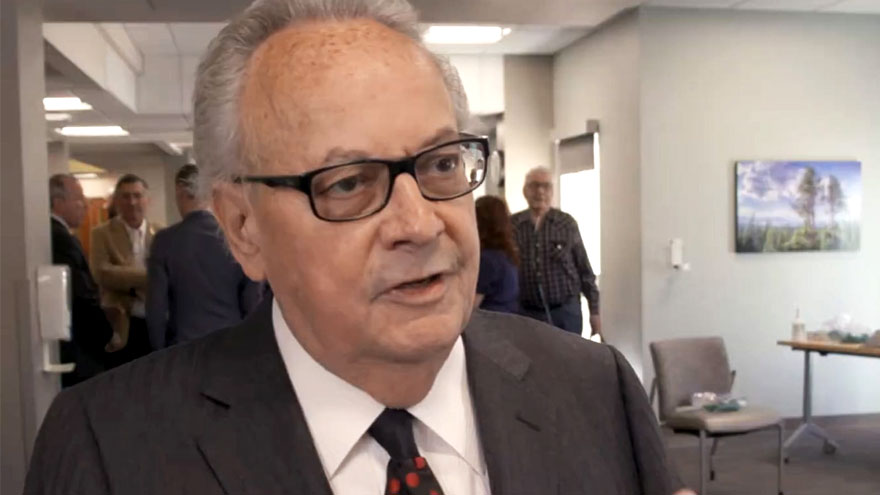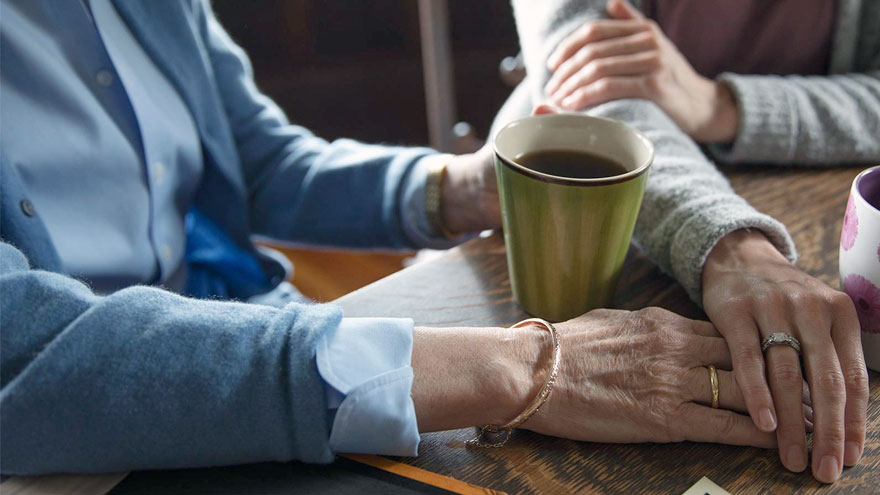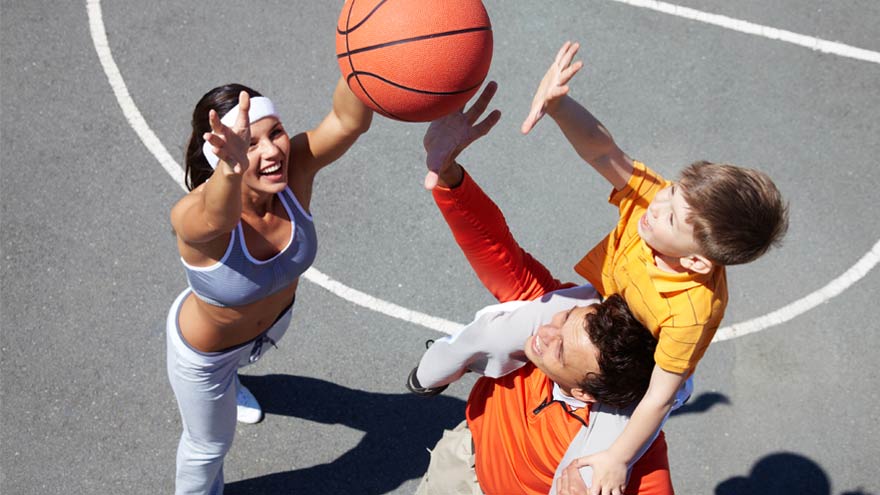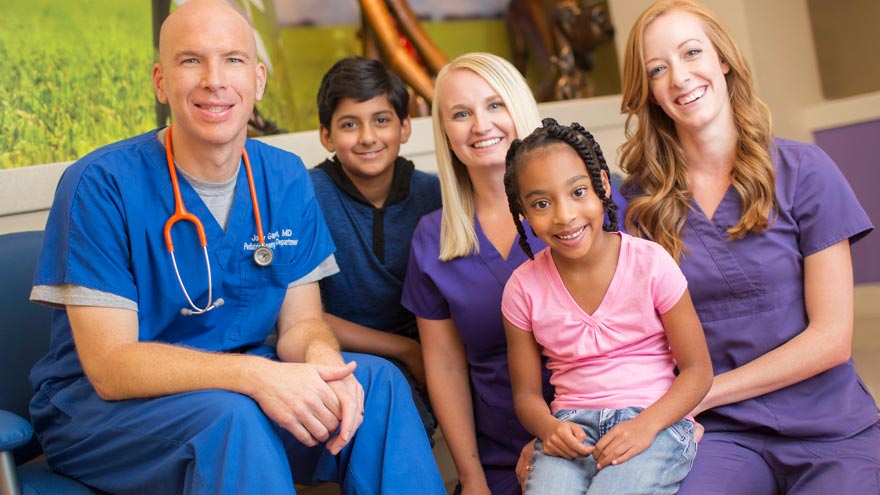Search
Results for 'doctor'
Clear-
Teens and Social Media: When Is it Too Much?
Dr. Max J. Coppes, Physician-in-Chief Renown Children’s Hospital, and Nell J. Redfield Chair of Pediatrics, UNR Med, talks about how much is too much when it comes to teens and social media. Social apps (Facebook, Instagram, Twitter, WhatsApp, Snapchat, TikTok, etc.) have become an integral part of most people’s lives. In contrast to traditional media — where one source goes to many receivers — social media operates in a dialogic transmission system. Many sources interact, sometimes simultaneously, with many receivers and provide for superior interactivity between its users. Not surprisingly, it also plays a significant role in our children’s lives once they are old enough to understand how to access and use these apps. On average, children start exploring social media at around ages 10 to 12. They rapidly discover that electronic communication allows for unique and personalized ways to make and keep friendships. They also use it to develop and expand family ties, get help with homework, share music, art, and experiences, and learn and discover the world. Social Media and Teens Surveys suggest that more than 90 percent of teenagers use social media. Additionally, approximately 75 percent have at least one active profile by age 17. Access to social media is greatly facilitated because more than two-thirds of teens have their own mobile devices with internet capabilities, a substantial change relative to previous generations. The use of social apps can have many positive aspects. But we now also recognize that it can also have negative impacts. The use of hazardous sites or the inherent risks of using social media (identity theft, being hacked, cyber-bullying, etc.) are indeed damaging to children. Any use of hazardous social apps is too much and carries serious hazards. But what about the use of “normal” and/or “safe” social media? Well, data suggest that too much use of “non-hazardous” apps can indeed affect health. How Much Do Teens Use Social Media? First, some basic data. For example, how much do normal teenagers use social media? A study from Pew Research found that more than 50 percent of 13- to 17 year-olds go online several times a day. This quickly increases during the teenage years to more than 70 minutes per day. Teenage girls have the highest usage at just over 140 minutes per day. It is important to recognize that non-school related use of the internet and social media is often beheld by teenagers as important for developing their self-esteem, their acceptance among peers, and their mental health in general. As parents, we recognize that the use of social media can indeed contribute, in many positive ways, to our children’s growth. At the same time, we also worry about them spending too much time online. We worry about their ability to communicate effectively in face-to-face settings or in writing. Many of us also feel and/or worry that our children are addicted. Social Media and Addiction Recent studies suggests that the overuse of social media indeed mirrors addiction. Reports now show that teenagers and college kids experience anxiety when deprived from their connected devices and consequently feel a compulsion to access their social applications. The emotional symptoms they experience are very similar to those seen in substance abuse. In fact, the American Psychiatric Association is considering making internet addition a bonafide diagnosis. Pediatricians therefore encourage limits on the use of social media, a recommendation more easily suggested than accomplished. So when should a parent consider seeking help? Aside from unhealthy use of these apps (cyber-bullying, sexting, online users asking for sexual relations, etc.), which should always trigger concern, the use of social media for more than 120 minutes per day should trigger parental concern. If you feel unable to address the overuse of social media, contact your pediatrician for help and guidance. Renown Children’s Hospital Whether it’s seeing a pediatrician, getting a sports physical or looking for advice, our care is centered around supporting and nurturing patients and families at our many locations. We have pediatricians dedicated to children who have experience recognizing children’s illnesses. They also have knowledge about tests and treatments for young ones to ensure your child gets the best care possible. Explore Children’s Services
Read More About Teens and Social Media: When Is it Too Much?
-
Taking Control of Her High Cholesterol and Health
In 2018, Jordan Stiteler became a Healthy Nevada Project advocate. Her DNA results revealed that she had Familial Hypercholesterolemia (FH). FH is a genetic condition that can cause high cholesterol. Since then, Jordan’s taken action to lower her cholesterol and make her family aware of this potentially dangerous condition. Read Part I of Jordan’s story Taking Control of High Cholesterol Looking at Jordan, an active young mother, you would never suspect she has high cholesterol. However, because of FH, Jordan’s cholesterol levels are unusually high. She chose to take action when learning of her FH gene, in order to maintain her long-term health. Jordan started by exercising more and eating healthier. “I’ve definitely been checking all the labels to see if the food has a lot of cholesterol, trans fats, or saturated fats,” she explains. She now eats a 100% plant-based diet which helps to lower her cholesterol naturally. Additionally, Jordan partnered with Dr. Michael Bloch, a lipid specialist, to monitor and manage her cholesterol. She told Dr. Bloch that she and her husband were planning on having a second baby. With this in mind, he helped Jordan create a plan to accommodate her pregnancy. Several months after giving birth to her beautiful daughter Logan, it was time to revisit her cholesterol treatment plan. Dr. Bloch prescribed Jordan a statin called Lipitor. It successfully cut her total cholesterol by half in just three months. “I had blood work done in November 2019 and my total cholesterol was 293 (normal is less than 199). I started taking cholesterol medication in February 2020. I had blood work done in June 2020 and my total cholesterol was 149, ” Jordan shares. “My LDLs went from 219 to 78! I am so grateful that the medication worked so well and so quickly! It’s a weight lifted off of my shoulders.” Although Jordan no longer limits herself to a strictly vegan diet, she is mindful of what she eats and how it affects her cholesterol. She’s thrilled that her cholesterol is now at a healthy level!
Read More About Taking Control of Her High Cholesterol and Health
-
Thomas S Dolan Pulmonary Rehabilitation Program
The program becomes first of its kind to be accredited in Nevada Renown Health is pleased to announce the certification of the Thomas S. Dolan Pulmonary Rehabilitation program at Renown South Meadows Medical Center by the American Association of Cardiovascular and Pulmonary Rehabilitation (AACVPR). AACVPR certification demonstrates that an organization's Pulmonary Rehabilitation Program is aligned with current guidelines set by the American Association of Cardiovascular and Pulmonary Rehabilitation for appropriate and effective early outpatient care of patients with cardiac or pulmonary issues. Certification offers peace of mind, so that patients can feel confident in knowing that staff has the experience and skills necessary to coordinate the many issues faced by people receiving a life-changing cardiac or pulmonary diagnosis. Pulmonary rehabilitation programs help people with health issues such as asthma, chronic bronchitis, pulmonary fibrosis, or chronic obstructive pulmonary disease (COPD) recover faster and live healthier. “Having access to quality pulmonary rehabilitation services so close to home, staffed by a highly skilled group of compassionate care providers, truly is a gift to our community,” said Tony Slonim,MD, D.Ph., president and CEO of Renown. “We are extremely proud of the work being done in our pulmonary rehabilitation program, and also forever grateful for Tom Dolan’s donation to the program in 2019, which empowers Nevadans to improve both their health and quality of life.” “Thomas S. Dolan Pulmonary Rehabilitation is the only accredited pulmonary rehabilitation program in the state of Nevada,” said Renown South Meadows Medical Center and Rehabilitation Hospital Vice President Chris Nicholas. “We take pride in this distinguished honor from the AACVPR as it acknowledges and amplifies the life-changing work happening here. Our dedicated caregivers provide support to our patients every step of the way, helping them lead vibrant and fulfilling lives despite their health conditions.” The comprehensive pulmonary rehabilitation program at Renown South Meadows Medical Center offers treadmills, stationary bicycles, strength training and an education classroom to help patients achieve health goals. To earn accreditation, Renown’s pulmonary rehabilitation program participated in an application process requiring extensive documentation of the program’s practices. AACVPR Program Certification is the only peer-review accreditation process designed to review individual programs for adherence to standards and guidelines developed and published by AACVPR and other related professional societies. In November 2019, Tom Dolan, owner and founder of Dolan Auto Group, donated to the Pulmonary Rehabilitation at Renown South Meadows Medical Center after his personal experience thriving in pulmonary rehabilitation brought northern Nevada’s capabilities, and needs to his attention. His generous donation has allowed Renown to double the number of patients who receive treatment and increase the access to pulmonary rehab in our community. “As a former patient myself, I found so much benefit in my pulmonary rehab,” said Dolan. “I have always wanted to support this program and increase the number of people it serves. It’s great to see that we now have the only certified pulmonary rehab in Nevada. “The most essential component of lung health is breaking the cycle of inactivity associated with lung disease,” said Lung Critical Care Physician Dr. Farah Madhani-Lovely. “Our community is fortunate to have an accredited program like this to empower our patients.” About AACVPR Founded in 1985, the American Association of Cardiovascular and Pulmonary Rehabilitation is a multidisciplinary organization dedicated to the mission of reducing morbidity, mortality and disability from cardiovascular and pulmonary disease through education, prevention, rehabilitation, research and disease management. Central to the core mission is improving the quality of life for patients and their families. Learn more about AACVPR at www.aacvpr.org.
Read More About Thomas S Dolan Pulmonary Rehabilitation Program
-
Pool Safety: Things To Know About Drowning
The warm weather is here and pools are open. Swimming is a great way to keep your kids cool, occupied and exercised throughout summer, however pools come with their fair share of risks. Before you take your children swimming, check out these pool safety tips. Pool safety is something every parent needs to take more seriously. Why? Because drownings of young children ages one to four have increased in recent years. Unfortunately, drownings are the number one cause of death in this age group - we lose the equivalent of 10 school buses full of children to fatal drownings in the U.S. each year. With warmer temps and hopes of cooling off in a local pool, you can’t be too careful when it comes to protecting your children from the risk of drowning. Children are naturally drawn to water, so parents must be extra aware in order to protect their kids from diving in headfirst. Kris Deeter, MD, pediatric intensive care physician at Renown Children’s Hospital, offers tips to keep your littles safe in the water. Preparing Your Child for the Pool People aren’t born knowing how to swim. This means parents must teach their children about swimming and pool safety if they want them to be safe and confident around water. It can take years to develop these skills, so the key is to start when your children are very young. Here are some ground rules: Teach your child to swim starting at age one. We recommend enrolling your toddler in swim classes; there are several organizations in the Reno-Tahoe area that offer baby and toddler swim classes. Keep your kids away from plastic and inflatable pools - they’re easy for children to fall or climb into and drown. They’re also a breeding ground for bacteria. Floaties and water wings are not safe! They are not a safe substitute or “crutch” for learning how to swim and they can lead to drowning if the child is using them incorrectly or while unsupervised. Stay within arm’s reach of babies and toddlers when at the pool. Supervision alone is not enough – you must be within arm’s reach in case they fall in and need to be rescued quickly. Learn child and infant CPR. If a drowning does occur, the best course of action is to call 911, get the child onto dry land and conduct CPR until breathing is restored or the EMTs arrive. Pool Parties: A Risk for Drowning? Surprisingly, pool parties, a common summer pastime, actually increase the risk of drowning incidents. Although responsible adults are usually at pool parties, distractions ranging from alcohol to pool toys can actually make it easier for drownings to occur unnoticed. Does this mean you should RSVP “no” to the next pool party your child is invited to? Not if you follow the pool safety tips below: Attend the party with your child so you can supervise them while they swim. Remove unused floaties and toys from the pool. They can obscure visibility, making it difficult to see a child in the pool. Don’t drink alcohol while supervising a pool party. Assign an adult “water watcher” to pay constant attention to children in the pool. Pool Safety Precautions for Homeowners If you own a pool, there are several more precautions to ensure the safety of your children. Even if your kids are strong swimmers who have mastered the rules of pool safety, there may be neighbors or friends who are younger and more vulnerable to drowning. You must undertake precautions for these children too. Some of these may seem time-consuming or expensive, but they are worth it to prevent a child from a fatal drowning. To keep your pool or spa safe, please: Cover your pool or spa when not in use. Choose a pool or spa cover with safety features like locks, safety sensors or alarms. Fence in your pool or spa area. The fence should be locked and at least four feet tall. Do not leave toys in the pool area as these may attract children.
-
Alzheimer’s Disease – How to Spot the Signs
Alzheimer’s disease is not normal forgetfulness as we age. Instead, it is a specific form of mental decline. And according to the Alzheimer’s Association it accounts for nearly 80 percent all dementia cases. Natasa Dragicevic, MD, PhD., behavioral neurologist and Alzheimer’s disease specialist with Renown Institute for Neurosciences, weighs in on diagnosing it and the importance of early medical action. How to Diagnose Alzheimer’s Disease In general, the signs of Alzheimer’s disease occur slowly, getting worse over time. For example, forgetfulness is a daily search – for shoes, keys and other misplaced items. Not only is memory affected, but also speech patterns and behavior. There is no single test for Alzheimer’s disease. “Specifically, a neurologist should be the one to diagnose Alzheimer’s disease given differences in presentation,” clarifies Dr. Dragicevic. “And ideally a behavioral neurologist (Alzheimer’s sub-specialist) will be managing the treatment,” she adds. Brain Imaging Diagnosing Alzheimer’s disease involves multiple approaches and medical providers. In short, medical history is reviewed along with a physical exam, lab tests and other diagnostic testing. “A medical workup includes a variety of tests. These include MRI and other brain imaging, as well as neurological and psychological testing. Furthermore, a lumbar puncture is performed to look for markers of the disease,” she states. What Causes Alzheimer’s disease? Although no one knows the cause, researchers think many factors play a role. Uncontrollable risk factors include your genetics and having a family member with the disease. However, the controllable risk factors include: reducing the risk of head injury and keeping your heart healthy. It’s important to realize that high blood pressure, high cholesterol, stroke and diabetes play a role in brain health. Blood loss to the brain causes vascular dementia, leading to long-term blood vessel damage. Symptoms of Alzheimer’s disease Generally speaking, the signs of this disease differ in each person. Yet noticeable behaviors include: • Losing the way to familiar places • Forgetting to pay bills • Trouble finding the right words when talking • Repeating questions • General confusion • Social withdrawal Alzheimer’s Disease – Benefits of Early Diagnosis Equally important, spotting Alzheimer’s disease early allows more time to benefit from medications and possible clinical trials. Likewise, nutrition and exercise changes can be made, increasing blood flow to the body, and perhaps delaying symptoms. Early diagnosis also allows for personal health decisions and quality-of-life conversations to take place. According to the Alzheimer’s Association, these benefits include: 1. Medical advantage 2. Emotional and social comfort 3. Time to plan ahead 4. Cost savings A Brain Supporting Lifestyle “At the present time, treatment is limited,” explains Dr. Dragicevic. “Usually Alzheimer’s is a progressive ongoing disease – any management at this time is purely symptomatic.” However, she states the following lifestyle changes can help support brain health: • New hobbies such as painting, pottery, music classes or learning a new language • Crosswords, puzzles and playing games, such as Scrabble • Brain challenging mobile apps, such as Luminosity • 30-45 minutes of mild to moderate physical activity per day, such as walking • Eating a Mediterranean diet (primarily plant based foods)
-
5 Easy Food Tips for Healthier More Beautiful Skin
What should you be eating for more radiant, youthful, beautiful skin? The answers may surprise you. Here’s insight from a medical aesthetician about what to eat, and what to avoid. Perhaps nowhere is the common refrain “You are what you eat” more clearly reflected than in your skin. The body’s largest organ — your skin — basically tells a tale of the foods you feed your body. So do more than apply the right creams and serums: Feed it the right foods! Here, Heidi Nicol, medical aesthetician with Renown Dermatology, Laser & Skin Care, walks us through which foods to eat and which to avoid for a healthy glow. Start with Fruits and Vegetables Fruits and vegetables are full of vitamins, minerals and antioxidants, which give them their brilliant colors. Eating a wide array of colorful fruits and vegetables will provide the necessary protection against cellular oxidation and the production of cancer cells. Avoid Sugar When you consume sugary food, the sugar in your bloodstream attaches to proteins like collagen and elastin fibers. This process, called glycation, forms harmful new molecules. This is important to note because these fibers keep skin firm and elastic. Once damaged, those fibers become hard, brittle and dry. What does this mean for your skin? This glycation process can actually age us, causing wrinkles, age spots, uneven skin tone and other negative effects. Beautiful Skin Vitamins A nutritious diet is essential to the maintenance of overall health and radiant skin. Consuming certain vitamins, minerals and other beneficial compounds is one of the best ways to improve its look and feel. Here are several universally-recognized essentials and a few of their common sources: • Vitamin A: Cod liver oil, cream, butter and egg yolks • Zinc: Liver, red meat, seafood, shellfish and pumpkin seeds • Vitamin C: Citrus fruits, bell peppers, dark leafy greens and broccoli • Omega-3 fatty acids: Salmon, tuna, walnuts, olive oil and flax seeds • Biotin: Egg yolks, liver, swiss chard, almonds and walnuts • Selenium: Chicken, beef, pork, cheese, sunflower seeds, brown rice, tuna and spinach • Silica: Leeks, green beans, garbanzo beans, strawberries, cucumber, mango and celery • Niacin: Red meat, poultry, tuna, salmon, seeds, milk, dark leafy vegetables, coffee and tea • Vitamin K12: Butter, egg yolks, liver, sauerkraut and cheese • Probiotics: Yogurt, kefir and fermented foods • Vitamin E: Soybeans, canola, corn and other vegetable oils, spinach, turnips, chard, sunflower seeds, almonds and bell peppers • Vitamin B5: Broccoli, tomatoes, strawberries, yogurt and whole wheat A nutrient-rich diet with these vitamins, minerals and other compounds will be a powerful tool in treating skin problems leading to a vibrant glow. Avoid Alcohol Drinking alcohol can cause enlarged blood vessels, burst capillaries, flushing, redness and angiomas (small, red moles). In addition, alcohol dehydrates your body, which makes skin appear less plump and fresh. Alcohol also breaks down the immune system, and the extra sugar in alcohol causes system inflammation, which contributes to cell damage and skin aging. To help combat some of these effects, be sure to alternate alcoholic drinks with water, which will help prevent you from getting too dehydrated. Drink Plenty of Water Speaking of water, an increase in wrinkles is a common response to lack of moisture. When cells are not fully hydrated by water (and water-rich foods), they cannot function properly. If you are not getting enough water, your skin turns dry, tight and flaky, and lines and wrinkles become more pronounced. Water aids in circulation, digestion, absorption and excretion. Proper water intake will lead to a radiant, healthy, younger looking complexion. Renown Dermatology | 775-982-8255 Renown Dermatology, Laser & Skin Care offers a comprehensive range of treatments and products to address any skin care need. Visit our beautiful office in south Reno and browse our product lines. Experts are available to answer any questions concerning your skin care and health and wellness needs. Request an Appointment
Read More About 5 Easy Food Tips for Healthier More Beautiful Skin
-
Low Back Pain – How to Stop the Ache
Low back pain is not only a problem most people have at some point in life, but also the leading cause of disability in the U.S. Whether it is a sharp spasm from lifting something heavy or a daily constant ache, there are various treatments available to relieve your pain. Jessica Ryder PT, DPT, cert VRS, with Renown Health Outpatient Therapy, explains some common causes of this pain, how to treat it and ways to prevent pain flare-ups. It’s important to realize most cases of low back pain are short term. Frequently lasting only a few days or weeks. In general these cases leave no long-term damage to the spine, muscles, discs or nerves. “However, it can become episodic or chronic (lasting longer than 12 weeks) if it is not properly understood or managed by the individual, ” cautions Ryder. Causes of Pain Specifically back discomfort can be related to: Wear and tear on the spine due to age or poor movement patterns Injury to spinal discs Sprains (overstretching or tearing of ligaments) and strains (tears in tendons or muscles) Trauma Irregularities of the spine present at birth (example: scoliosis)Notably the above issues may result in a “pinched nerve” or sciatica, causing pain to extend down the leg. Risk Factors for Pain In particular, your chance of developing low back pain increases with the risk factors below: Age Being overweight Low fitness level or occasional physical activity (“weekend warrior”) Family history Pregnancy Poor posture Jobs requiring heavy physical work (landscaping, plumbers, construction, etc.)
-
Not a Fall Sports Fan? Ways to Keep Kids Active
The mornings are crisp and it’s about time to pull out those scarves and boots, so what does that mean? Football, baby! But not all kids are fans of fall sports. Elaina Lantrip, an advanced practitioner with Renown Pediatrics talks about how to keep kids active if they’re not in love with fall sports. Fall in northern Nevada means tailgates, Saturdays at the field, football fun and prep time for basketball season. But oddly enough, we parents aren’t in control of our kids’ likes and dislikes — shocking, we know. This means sometimes kids don’t like the fall sports we enjoy. So how do we keep them active even if they’re not a fan of football, basketball or any sport ending in “-ball”? We asked Elaina Lantrip, APRN for Renown Pediatrics, for some tips. Activities for Kids Who Don’t Like Fall Sports What are some reasons kids may not be interested in sports? Team sports are often the go-to option to get your children more active. But there can be a number of reasons your child may not be interested. First, many fall sports are open to preschoolers, but it’s not until age six or seven that most kids have the attention span, physical skills and can fully grasp the rules. If your child is nervous about their abilities, try practicing at home before quitting the sport. You may find your child becomes more interested as they become more confident in their skills. Other kids may find team sports too competitive and feel too much pressure to play perfectly for their coach and teammates. If possible, evaluate the coach and league before signing up to find out how competitive they are. Doing so ahead of time may help you find the right fit for your little one. What do you suggest to keep kids moving when they don’t like fall sports? Some kids just don’t enjoy sports or would prefer to do something on their own, and that’s fine too. Kids can still get the 60 minutes of exercise they need each day in other ways. Free play such as shooting baskets, riding bikes, playing tag or jumping rope can be good options or they may be interested in individual sports such as swimming, horseback riding, dance lessons, roller skating or skateboarding, hiking, golf, tennis, gymnastics, martial arts, yoga, running or cheerleading. All of these are good options because they keep your child active and moving, but may fit better with what they’re interested in and truly enjoy. How can you work with your child to find which activity is best for them? Finding the right fit can be a challenge. It’s important to be patient as it may take several tries at different sports or activities to find the right activity. Start by explaining to your child they need to take part in some activity. Work with your partner to create a list of options you both agree on and see what interests your child. Once your child makes their pick, make them stick with it through one season or a full set of lessons to ensure they get a complete idea of what’s involved. One game or one lesson isn’t enough to decide it is or isn’t for them. What are some easy ways to be active indoors? Even though staying indoors can be a bit of a bummer, there are plenty of options to help your kids and yourself stay active while enjoying some quality time together. You can plan a scavenger hunt, build a fort, set up hopscotch in the hallway, throw a dance party and make everyone freeze each time the music stops, create an indoor obstacle course, hula hoop or play tag in the living room. As your kids get older, playing video games that require movement and mimic sports or physical competitions are good options. Your kids may even join in on a workout DVD or you can have a friendly contest to see who can do the most pushups and sit ups in one minute. BestMEDICINE Kids Subscribe to BestMEDICINE Kids and receive a monthly email featuring educational and inspirational stories dedicated to kids health and wellness from pregnancy through childhood. Join Today!
Read More About Not a Fall Sports Fan? Ways to Keep Kids Active
-
Children's ER, Urgent Care or Wait it Out? Here's Your Guide
We’ve all been there: Your child gets sick right after urgent care closes — or worse, in the middle of the night. So do you wait it out, or do you load up and head to the Children’s ER? Pediatric Emergency Physician Joey Gassen, MD, with Northern Nevada Emergency Physicians, has insight. As parents, we often wish we had all the answers. And while a short-and-sweet comprehensive parenting guide is elusive, we can help if your questions involve whether to go to the children’s ER or wait it out. Here, a pediatric emergency physician explains when you should take your child to the Children’s ER at Renown Children’s Hospital, and what makes a children’s ER different. How do you know when it’s time to take your child to the ER? Having a sick or injured child is stressful. If you have a true emergency, you should go straight to the ER or call 911. When to go to the ER: Allergic reactions Asthma or severe shortness of breath Fever (infants less than two months old) Choking or poisoning Coughing up or vomiting blood Fainting, confusion or seizures Fractures or broken bones Head injuries Severe bleeding If you determine your child’s condition isn’t life-threatening but needs to be taken care of right away, urgent care is the best choice. Those conditions include: Cold and flu Coughs and sore throat Fevers Vomiting, diarrhea, stomach pain Cuts and severe scrapes Minor injuries and burns What is different about Renown Children’s ER compared to the adult ER? The difference starts when you first bring your child in. We have a lobby dedicated to our community’s smallest patients. The 24/7 lobby incorporates a child-friendly atmosphere with vibrant colors to help decrease anxiety that can accompany emergency situations. Our children’s ER also has equipment sized just for kids of any age. We offer a distraction machine, as well as games and movies, to help children cope with what can be a traumatic experience, like getting an IV. In addition, we have Child Life Specialists available to provide the emotional support to both children and their families. Why is it important to have an emergency room and lobby open 24/7 dedicated to children? Children aren’t just little people. They have special needs that require specialized care. Our children’s ER is staffed with skilled physicians and pediatric nurses certified in advanced pediatric emergency care to give your child the highest level of support. Renown Children’s Hospital From newborns to teens, Renown Children’s Hospital offers many different services and treatments designed specifically to take care of our community’s children. We provide a range of specialized services — from a dedicated Children’s ER and Pediatric ICU to a children’s imaging center and child’s asthma program. Explore Children’s Services
Read More About Children's ER, Urgent Care or Wait it Out? Here's Your Guide
-
Is Bariatric Surgery Right for You?
You’ve likely heard about bariatric surgery — and perhaps even have friends who’ve done it. But is it a potential solution for you? Here, Dawn Remme, RN, Metabolic Bariatric Surgery Program Manager, provides insight. You may have been struggling with excess weight for years. You’ve tried high-protein diets, low-carb diets and more. Most patients considering weight loss surgery have tried numerous dieting methods. The truth is, some patients who suffer with obesity are successful dieters. Unfortunately though, excess weigh often returns. This impacts their health and the quality of their life. It can be a disheartening battle. Weight loss surgery is a big decision. In making this decision, keep in mind that surgery is only one step toward your goal of achieving better health. It is neither magic, nor is it the “easy way out.” Weight loss surgery can offer you a TOOL to help you become more successful in controlling the disease of morbid obesity. By combining this tool with a lifelong commitment to important lifestyle changes, medical follow-up and nutritional modifications, you have the potential to become a healthier you. Bariatric Surgery By the Numbers Exploring the facts about obesity, how it impacts your health, and how surgery can resolve or significantly improve your chronic medical conditions is the first step to making a decision. Obesity is medically defined as “excess body fat” and is measured by a mathematical ratio known as the Body Mass Index (BMI). To calculate your BMI, we consider your height, weight, age, gender and body build. Here are the standards: “Normal” BMI: less than 25 Overweight: 25 – 29.9 Obese: BMI of 30 – 39.9 Morbid obesity: BMI of 40 or more Morbid obesity (BMI over 40) is a lifelong, progressive disease, and the prevalence of morbidly obese Americans (100 or more pounds over a healthy weight) is increasing rapidly. According to the CDC, the disease of obesity affects 78 million Americans. Further estimates indicate about 24 million have morbid obesity. Serious medical problems known as co-morbidities often occur when someone is morbidly obese. Studies tell us conditions such as type 2 diabetes, high cholesterol, sleep apnea, high blood pressure and degenerative arthritis increase in severity as the BMI is increasing in patients. When may weight loss surgery be an option? When someone has a BMI greater then 40. If a person’s BMI is 35 – 39.9 and they have significant health problems such as type 2 diabetes, high blood pressure, high cholesterol, sleep apnea, or other diagnosed health conditions related to obesity. Gastric Sleeve, Gastric Bypass Explained To resolve or significantly reduce these health conditions, bariatric surgery can be done when diet and exercise haven’t worked. Weight loss surgery makes changes to your digestive system to help you lose weight. The gastric sleeve limits how much you can eat, whereas gastric bypass limits how much you can eat and reduces the absorption of certain nutrients. Other Benefits of Surgery You can greatly increase life expectancy by resolving or significantly improving conditions like diabetes, high cholesterol, high blood pressure, sleep apnea, and obesity itself. Infertility can also be positively affected. A significant weight loss and relief from serious health conditions and diseases will greatly improve your quality of life. Studies tell us that type 2 diabetes is resolved or significantly improved in 84 percent of patients following bariatric surgery. Cholesterol levels dropped in 95 percent of patients. And hypertension and sleep apnea showed improvement in 68 and 80 percent of patients, respectively, following bariatric surgery. Bariatric Surgery at Renown In making the decision to move forward to better health, it is important to remember: Obesity is a disease, and the desire to have a healthier, longer, more fulfilling life is possible. If you are interested in learning more, please visit the Bariatric Surgery Program page to view more information about Renown Regional Medical Center’s MBSAQIP accredited bariatric program, as well as information about upcoming educational seminars. Or call 775-982-RSVP (7787) to reserve your seat. Learn More
-
Dietitans' Top Advice to Avoid Holiday Weight Gain
The weight gain struggle is real with tempting holiday celebrations and treats. It’s hard to focus on nutrition with social events, shopping and a hectic schedule. And no one wants to diet during the holidays. Renown Health Registered Dietitians Kim Colegrove and Bristy Zimmerman, share their tips below for enjoying the holiday season without packing on extra pounds. Your holiday nutrition strategy doesn’t have to be all or nothing. Instead, Colegrove and Zimmerman emphasize realistic approaches to keep weight gain in check during the holidays. Plan Ahead to Avoid Weight Gain “Thinking ahead is key for staying on track with your weight and health goals,” says Colegrove. “Arranging to have a healthy snack ahead of time is a good idea to avoid overeating at parties. You could also bring a healthy dish to the party, then you know there’s at least one option that will fit into your meal plan. Or you might also think about eating some of your favorite party foods, but then consider the rest of your week and balance it out accordingly. All foods can fit! It’s all about balance and portion control.” Keep Moving Your Body Colegrove also urges us to stay active. “There are so many benefits of exercise! Besides aiding in weight management, physical activity can boost our mood and help us to cope with stress. For many, the holidays can be a very busy and stressful time, which may contribute to overeating and weight gain. So keep up the routine! Exercise is a vital tool in maintaining weight and managing stress, especially during the holiday season.” Slow Down and Be Satisfied “Slowing down at any meal, including the holidays, can help us pay attention to our satiety or fullness cues,” encourages Zimmerman. “Try putting your fork down between each bite of food, focus on chewing eat bite thoroughly and stop eating when you feel satisfied rather than eating to the point of discomfort.” Divide Your Plate to Conquer Weight Gain Traditional holiday foods tend to be high in calories from added fat and sugar, so it’s extra important to be mindful of our portions. Zimmerman suggests an easy visual cue. “First, try filling half of a 9-inch plate with lower-calorie foods like non-starchy veggies or salad. Secondly, fill a quarter of your plate with a meat or protein-rich food. Then save the remaining quarter of your plate (about the size of your fist) for the higher-calorie carbohydrate foods like mashed potatoes, stuffing, or cornbread. If you want to enjoy several of these foods, just make the portions small enough to still fit in that quarter of your plate.” Liquid Calories Count “Still or sparkling water will always be the best beverage choice when avoiding weight gain,” advises Zimmerman. “If you really enjoy holiday beverages, try modifying your favorite recipes by using low-fat milk or alternative sweeteners. Be mindful that calories from sweetened beverages and alcohol can add up fast. For example, if you usually enjoy several drinks at a holiday party, even reducing from three drinks to one drink can save significant calories.” You can set yourself up for success in the new year by having an eating game plan. “It’s important to be realistic about the holidays. They only come once a year, and they should be enjoyed! But plan ahead and find a good balance,” urges Colegrove. “Going into the holidays, it’s important to anticipate temptations and be prepared at social events. Don’t let the holiday season derail your efforts and enjoy in moderation!”
Read More About Dietitans' Top Advice to Avoid Holiday Weight Gain
-
Fall Recovery Gets Patient Back to Life and Movement
Standing at the top of the stairs to the basement Sharon Sturtevant was chatting with her grandson in the kitchen. Suddenly, Sharon stumbled and fell down the stairs. “The last thing I remember was my head hitting the floor before everything went black,” she recalls. Her grandson, Oliver, quickly called 911 and paramedics arrived on the scene, taking her by ambulance to Renown Regional Medical Center where she was diagnosed with a broken collarbone and a neck fracture that would require complex surgery involving fusion of her neck. Fall Recovery Begins After her surgery, Sharon was transported to the Renown Rehabilitation Hospital and her recovery process began. Sharon smiles as she describes the rehab hospital team “They are fabulous here, I learned so much about how my body moves, and the proper way to move it. At home I wouldn’t have known what to do,” she confesses. “They set me up for success to return home and not get injured again.” At Renown Rehabilitation Hospital, different therapists coordinated a custom plan to help Sharon recover from her injuries. Ultimately, the goal of her physical therapy was to help restore and improve her strength, reduce pain and increase her mobility for stamina and balance. Physical Therapy Key to Successful Treatment of Falls “My recovery after the operation was an eye-opener,” Sharon declares. “I had no idea how much went into regaining everyday moment.” During her rehabilitation hospital stay, she had to re-learn how to swallow, go up and down stairs, as well as successfully get in and out of a wheelchair, which involved transferring her body weight safely. Due to hormonal changes after menopause women are 50% more at risk for falls than men, according to research. Sharon now has a greater awareness of how to move her body and is significantly stronger than before entering her physical rehabilitation sessions. Not everyone knows that everyday mobility is impacted by four basic skills: stepping, trunk flexibility, upright posture and weight shifting. “I don’t know how I could have gotten this far without the wonderful therapists here,” she shares. “They are so thorough. Proper alignment was encouraged helping me to walk and stand correctly. They were all so nice and patient with me,” she states. “I actually had less pain because I didn’t hurt myself moving the wrong way.” Falls Are Common Among Aging Adults As we age balance becomes more important. Unfortunately falls are common among older adults with negative quality of life effects, even fatalities. According to the Centers for Disease Control and Prevention (CDC), one in four seniors fall each year in the U.S. A comprehensive physical therapy plan for sudden falls or chronic conditions is a safe, effective alternative treatment to medication such as opioids. Today Sharon is back at home with a new banister installed on the basement stairs. As a music lover she is enjoying her musical grandchildren Oliver and Eliana who play instruments. She looks forward to attending their upcoming school concerts. Sharon remembers the staff at Renown Rehabilitation Hospital fondly, “They were unfailingly patient, supportive, informative and understanding.” Her advice to those unexpectedly finding themselves in the rehabilitation hospital is, “Listen to your therapists carefully and follow their instructions.”
Read More About Fall Recovery Gets Patient Back to Life and Movement











